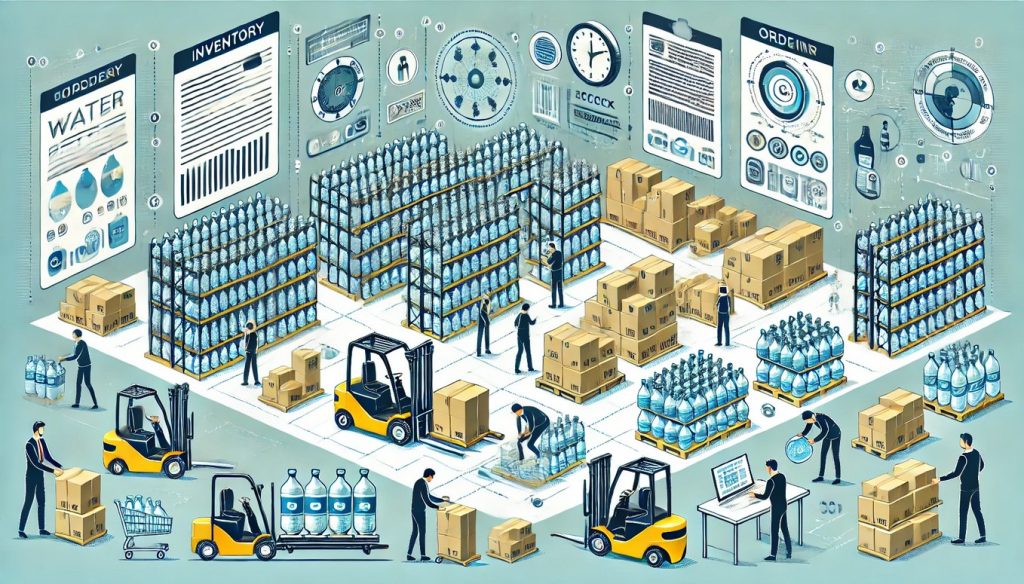The Complexity of Managing Large Orders of Water Bottles
Managing large orders of water bottles can be a challenging yet rewarding task for any business in the water bottle industry. Whether you are a manufacturer, distributor, or retailer, handling large volumes of products requires a strategic approach to ensure timely delivery, minimal errors, and high customer satisfaction. With the increasing demand for custom, eco-friendly, or branded water bottles, businesses must be prepared to scale up their operations to meet the needs of bulk buyers, whether for corporate gifts, events, retail, or wholesale.
Efficient management of large water bottle orders involves careful planning, effective coordination, and utilizing the right tools and systems. From procurement and inventory management to packaging, shipping, and customer service, every stage in the process must be optimized to handle large-scale orders efficiently.
Streamlining Order Management Systems
Implementing a Robust Order Management System (OMS)
The backbone of efficiently managing large orders is a strong and reliable Order Management System (OMS). An OMS allows you to track, process, and manage orders from start to finish, ensuring that no steps are missed. A good OMS will help you manage product availability, customer orders, shipping details, and invoicing all in one place.
An effective OMS can automate many of the routine processes associated with order fulfillment, reducing the risk of human error and speeding up the process. This automation can include generating packing slips, updating inventory levels in real-time, and sending notifications to customers about order status and shipping details. With an OMS, businesses can ensure a seamless workflow from order placement to delivery.
Real-Time Inventory Tracking
Efficient management of large orders requires accurate, real-time visibility into inventory levels. By using an inventory management system integrated with the OMS, you can track stock levels, monitor product movement, and quickly identify potential shortages.
For example, if a large wholesale order is placed for a specific type of water bottle, the system should immediately notify the team if there are insufficient quantities in stock, allowing for proactive action such as replenishing inventory or notifying the customer about potential delays.
Handling Backorders and Order Modifications
When managing large orders, there is always the possibility of backorders or order modifications. A strong OMS can handle these scenarios by providing options to notify customers, offer alternatives, or manage updated delivery timelines. In addition, being able to track and manage multiple order changes across a large volume can prevent confusion and help avoid costly mistakes.
Centralized Communication
Effective communication between departments is essential when handling large water bottle orders. The OMS serves as a central point for all communication related to an order, from sales to logistics, ensuring that every team member has the latest information. For example, once an order is placed, the sales team, inventory department, and shipping team are all notified, allowing them to coordinate and fulfill the order efficiently.
Efficient Inventory and Warehouse Management
Optimizing Warehouse Layout and Space Utilization
Proper warehouse organization is critical when managing large orders. Water bottles, especially in bulk quantities, require significant space for storage. Optimizing warehouse layout to ensure maximum space utilization can significantly improve the speed and efficiency of order fulfillment.
For example, organizing inventory by product type or order size can reduce the time spent searching for products. If large water bottles are stored separately from smaller ones or from custom-printed bottles, it helps to speed up picking and packing. Additionally, placing high-demand products near packing stations ensures that employees can quickly access them when fulfilling orders.
First-In, First-Out (FIFO) Method
To avoid product obsolescence and maintain optimal product quality, it is important to implement a First-In, First-Out (FIFO) method of inventory management. In this method, the oldest stock is used first, ensuring that products with earlier production dates are shipped before newer stock. This is especially important for businesses that sell water bottles with varying design or packaging options, where old stock might need to be cleared before newer designs take over.
Automated Inventory Control
Automation can help businesses manage large orders more effectively by reducing human error and minimizing the need for manual stock counting. Barcode scanners, RFID tags, and inventory management software can help track products in real time, updating inventory levels as bottles are sold, packed, or shipped. This real-time visibility prevents stockouts, ensures orders are fulfilled on time, and helps businesses maintain optimal inventory levels.
Safety Stock and Buffer Inventory
When dealing with large orders, unexpected fluctuations in demand can lead to stockouts or delays. To account for these uncertainties, maintaining safety stock or buffer inventory can help ensure that you always have a buffer to meet demand. Calculating the right amount of safety stock involves analyzing historical sales data, trends, and seasonality, allowing businesses to predict when demand spikes and maintain an adequate supply of water bottles.
Packaging Large Orders Efficiently
Custom Packaging Solutions for Bulk Orders
One of the most significant challenges when managing large water bottle orders is packaging. Wholesale orders often require bulk packaging solutions that can handle large quantities of bottles while minimizing the risk of damage during transit. Custom packaging solutions, such as corrugated boxes, customized inserts, and pallets, can provide better protection and more efficient use of space.
When designing packaging for large orders, it’s essential to consider the size, weight, and fragility of the water bottles. For example, heavier or more fragile bottles (such as glass or stainless steel) may require additional cushioning or specialized packaging to prevent breakage. Custom inserts or dividers can keep bottles separated, preventing them from colliding or rubbing against each other.
Eco-Friendly Packaging Materials
Sustainability is a key consideration for many businesses and consumers today. When handling large orders, businesses can reduce their environmental footprint by using eco-friendly packaging materials such as recycled cardboard, biodegradable packing peanuts, or corrugated trays. Additionally, offering customers the option to reuse or recycle packaging materials can align with sustainability goals and create positive brand perceptions.
Packaging Automation
Automating the packaging process can significantly improve efficiency and consistency when managing large orders. Automated packaging machines can quickly wrap, box, and seal water bottles, reducing labor time and the risk of errors. Additionally, automated packaging systems can handle different sizes and types of packaging, allowing businesses to scale up quickly and process bulk orders more efficiently.
Efficient Shipping and Delivery Logistics
Choosing the Right Shipping Partners
Shipping large orders of water bottles requires reliable logistics partners who can handle bulk shipments, offer competitive rates, and ensure timely delivery. When selecting a shipping provider, consider factors such as delivery speed, shipping costs, package tracking capabilities, and customer service. Partnering with multiple logistics providers can also help businesses find the most cost-effective shipping options based on the size and destination of the order.
For international shipments, it’s essential to work with logistics companies that are familiar with customs regulations, taxes, and import duties. Understanding these regulations and working with experienced partners can help avoid delays or unforeseen costs during the shipping process.
Shipping Optimization and Route Planning
To maximize efficiency and reduce costs, businesses can implement shipping optimization tools that calculate the best shipping routes and methods. These tools can help determine the most cost-effective delivery options based on order size, weight, and location. By optimizing delivery routes and consolidating shipments when possible, businesses can reduce fuel costs and minimize environmental impact.
Real-Time Tracking and Customer Notifications
Offering real-time tracking is crucial when managing large orders of water bottles. Providing customers with access to tracking information helps to keep them informed about the status of their order and reduces the need for customer service inquiries. Many order management systems and shipping platforms offer automatic tracking number generation and customer notifications, ensuring that customers are updated on their order status throughout the shipping process.
Managing Customer Relationships and Communication
Setting Clear Expectations
Clear communication is essential when managing large orders. One of the most important aspects is setting clear expectations with customers regarding delivery times, stock availability, and potential delays. If an order is large, complex, or involves custom bottles, make sure the customer knows when they can expect their order to be processed and delivered. Keeping customers informed throughout the order process can help build trust and prevent frustration.
Handling Order Changes and Cancellations
In the case of large orders, customers may sometimes request changes, modifications, or cancellations. It’s important to have a flexible system in place that can quickly process these changes without causing delays. For example, if a customer wants to change the quantity of water bottles, update their shipping address, or cancel part of their order, these changes should be logged in the system and reflected in inventory and shipping statuses in real time.
Additionally, it’s essential to communicate promptly with customers about any potential issues. If there is a stock shortage or delay, informing the customer early on and offering alternative solutions (such as backordering or suggesting a similar product) can help avoid negative experiences.
Providing Excellent Customer Service
Large orders often come with higher expectations, so providing excellent customer service is crucial. Ensure that customers have multiple ways to reach you—whether through email, phone, or live chat—so they can easily ask questions or resolve issues. Proactively reach out to customers to confirm their orders, notify them of shipment tracking information, and ensure their satisfaction upon delivery. Maintaining a responsive and helpful customer service team helps build lasting relationships and encourages repeat business.
Leveraging Technology for Efficiency
Integrating Technology Across Operations
Technology can play a crucial role in improving the efficiency of managing large orders. For example, integrating Warehouse Management Systems (WMS) with your Order Management System (OMS) and Inventory Management System (IMS) allows for seamless communication between all parts of the operation. This integration reduces errors, minimizes the need for manual data entry, and provides real-time updates on stock, order processing, and delivery.
Additionally, adopting cloud-based solutions allows for remote access to key business systems, making it easier to manage orders from multiple locations or track shipments in real time. Cloud technology also enhances collaboration between different departments (sales, inventory, logistics, and customer service), ensuring a smooth process when managing large water bottle orders.
Artificial Intelligence (AI) and Predictive Analytics
AI and predictive analytics can help businesses anticipate demand, optimize inventory levels, and improve forecasting accuracy. By analyzing historical sales data, AI tools can predict when large orders will be placed and help businesses prepare in advance. Predictive analytics can also help optimize supply chain processes, reducing the risk of stockouts or overstocking.







